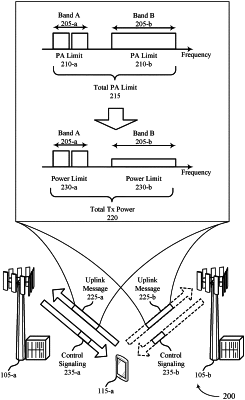| CPC H04W 52/281 (2013.01) [H04W 52/146 (2013.01); H04W 52/367 (2013.01); H04W 72/23 (2023.01)] | 30 Claims |

|
1. A method for wireless communications at a user equipment (UE), comprising:
receiving, from a base station, control signaling that schedules uplink transmission of a first uplink message via a first radio frequency spectrum band and a second uplink message via a second radio frequency spectrum band;
selecting, to satisfy an uplink transmission power criterion, a first transmission power level for transmission via the first radio frequency spectrum band and a second transmission power level for transmission via the second radio frequency spectrum band based at least in part on a function of UE transmission power over a preceding time interval; and
transmitting the first uplink message via the first radio frequency spectrum band at the first transmission power level, or the second uplink message via the second radio frequency spectrum band at the second transmission power level, or both.
|